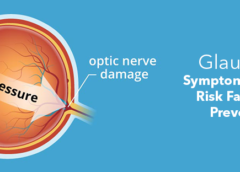Glaucoma
Glaucoma is a group of eye conditions that damage the optic nerve, the health of which is important for good vision. This damage is often caused by abnormally high pressure in your eye.
Glaucoma is one of the leading causes of blindness for people over 60 years old. It can occur at any age but is more prevalent in older adults.
Most types of glaucoma may not have warning signs. The effect is so incremental that you may not detect a change in vision until the condition is at an advanced.
Since it is not possible to restore vision loss due to glaucoma, routine eye examinations that provide measurements of the eye pressure are necessary so that a diagnosis can be made in its early stages and treated accordingly. Vision loss can be a delay or prevent if glaucoma is detected early. If you have the disease, you will usually require treatment for the rest of your life
Glaucoma Symptoms
The glaucoma signs and symptoms differ according to the form and stage of the disease. For instance:
Open-angle glaucoma
- Patchy blind spots in your side (peripheral) or central vision, frequently in both eyes
- Tunnel vision in the advanced stages
Acute angle-closure glaucoma
- Severe headache
- Eye pain
- Nausea and vomiting
- Blurred vision
- Halos around lights
- Eye redness
If left untreated, glaucoma will eventually cause blindness. Even with treatment, about 15 per cent of people with glaucoma become blind in at least one eye within 20 years.
When to see a doctor
Promptly go to an emergency room or an eye doctor’s (ophthalmologist’s) office if you experience some of the symptoms of acute angle-closure glaucoma, such as severe headache, eye pain and blurred vision.
Causes ofGlaucoma
Glaucoma causes damage to the optic nerve. When this nerve deteriorates slowly, blind spots form within your field of vision. For reasons that doctors don’t fully understand, this nerve damage is usually related to increased pressure in the eye.
Elevated eye pressure is due to a fluid accumulation which flows through the inside of your eye. This internal fluid normally drains out through a tissue called the trabecular meshwork at the angle where the iris and cornea meet. If the fluid is overproduced or the drainage system is not working properly, the fluid cannot flow at its normal rate and the pressure of the eye increases.
Glaucoma tends to run within the family. Scientists have identified genes in certain people that contribute to high eye pressure and damage to the optic nerves.
Risk factors
Since chronic types of glaucoma can kill vision before any signs or symptoms become evident, be aware of these risk factors:
- Having high internal eye pressure
- Being over age 60
- Being black, Asian or Hispanic
- Having a family history of glaucoma
Having some medical conditions, like diabetes, heart disease, high blood pressure and sickle cell anaemia
- Having thin corneas in the middle
- Being extremely nearsighted or farsighted
- Having had an eye injury or certain types of eye surgery
- Taking long-term corticosteroid medicines, particularly eye drops
Prevention
Such measures in self-care will help you detect glaucoma in its early stages, which is crucial for preventing loss of vision or slowing progress.
- Get regular dilated eye tests: Regular, thorough assessments of the eye can help diagnose glaucoma in its early stages until there is serious damage. As a general rule, the American Academy of Ophthalmology recommends having an eye exam every 6 to 12 years if you are under 38 years of age; every 3 to 5 years if you are 38 to 53 years of age; every 1 to 4 years if you are 54 to 64 years of age, and every 1 to 2 years if you are older than 64. If you are at the risk of glaucoma, more regular screening would be required. Ask the doctor to recommend you the correct timetable for screening.
- Know your family’s eye health history: Glaucoma tends to occur within a family. If you’re at elevated risk, you may need to check more frequently.
- Healthy workout: Regular, moderate exercise by reducing eye pressure will help prevent glaucoma. Speak to your doctor about a good fitness plan.
- Take daily eye drops as prescribed: Glaucoma eye drops can significantly minimize the risk that high eye pressure will progress to glaucoma. Eye drops recommended by your doctor ought to be used daily to be safe even though you have no symptoms.
- Wear an eye mask: Serious injuries to the eyes can cause glaucoma. Whether using power tools or playing high-speed racket sports in enclosed courts wear eye protection.

Leave a Reply
You must be logged in to post a comment.